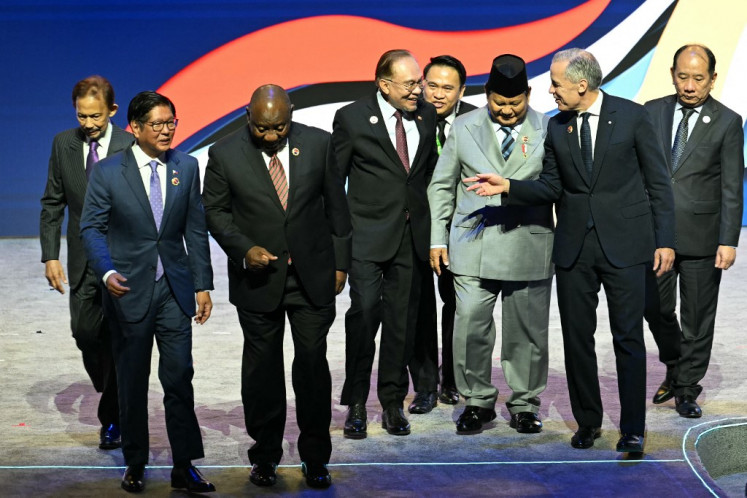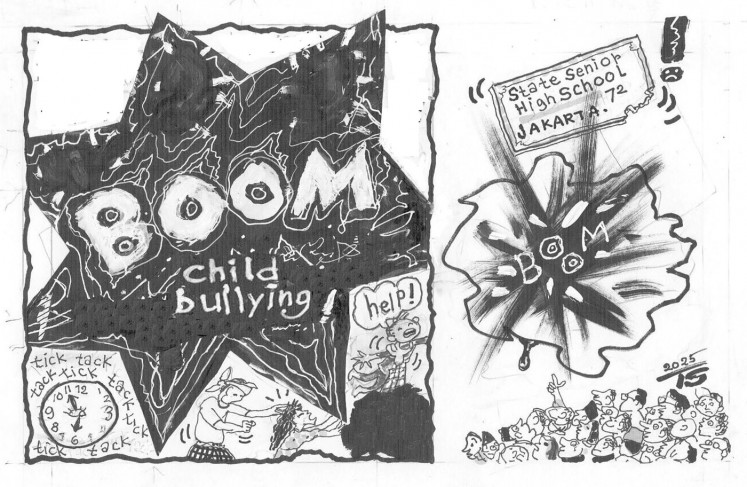Popular Reads
Top Results
Can't find what you're looking for?
View all search resultsPopular Reads
Top Results
Can't find what you're looking for?
View all search resultsInsight: AI and Efficiency: Sacrifices The Next Generation
Change text size
Gift Premium Articles
to Anyone
Introduction: From One Disruption to Another
We have never been ready for all the surprises the world gives us: Five years ago, no single country was prepared to manage the COVID-19 pandemic, with every line of activity shut down. As companies closed, more than 9.2 million jobs were lost in Southeast Asia in 2020, with the unemployment rate increasing from 5.3 percent in the first quarter of 2020 to 17.6 percent in the second quarter.
While global resilience allowed countries to slowly pick up the pieces, the turmoil was further exacerbated by conflicts that disrupted the supply chain, such as the Russia-Ukraine conflict in 2022, as well as the economic policies of several countries, such as the United States’ tariff policy this year.
Amid the economic slowdown, efficiency quickly became a hot topic, particularly with regard to employment and the AI boom that peaked with the launch of ChatGPT in 2022. Approximately 30 percent of current US jobs could be automated and up to 60 percent of current jobs will need significant adaptation due to AI.
Collapsing stepping stone for young talent
Perhaps we could take this time to reflect on the early days of our careers. How did we gain our work experiences? Writing proposals and reports? Helping our superiors analyze data? Participating in video shooting workshops? Writing research papers for publication?
All of our tasks as “recent graduates” can be replaced by artificial intelligence very quickly and cost-efficiently simply because the technology skips over the process of developing and training employees. In the next five years, 44 percent of the skills needed by workers will change, with entry-level jobs being the most vulnerable to automation.
Besides AI adoption, one of the most common efficiency measures for companies amid the economic slowdown is to reduce their workforce.
The World Economic Forum's 2025 report on workforce strategy in response to AI in 2025-2030 found that 41 percent of employers would downsize their workforce as AI grows increasingly capable of replicating roles. AI advancements could also lead to a decrease in entry-level jobs and limited opportunities for on-the-job learning that are important for early career growth.
Of these two trends, basic jobs are being replaced by AI and employee redundancies have become a common threat for talent regeneration, with exposure to real work experiences becoming very limited for recent graduates as job opportunities grow increasingly difficult to find.
Tech disruption is nothing new. So what’s changed?
Frankly speaking, technological unemployment is not a new phenomenon. The advancement of technology has always been followed by human versus machine issues, but there are always new opportunities on the horizon.
The Industrial Revolution replaced manual labor with machines, while the advent of the computer replaced manual administrative work. The cycle continues with the trend of efficiency as AI replaces basic jobs.
What is different this time is speed and scope. Where technological transitions used to take decades, they now happen in years or even months. Moreover, AI is replacing not just physical or administrative jobs but also cognitive work, including analysis, writing and even basic creativity.
A 2024 survey by Deloitte in the US, Canada, India and Australia that included workers in their early careers making up 65 percent of respondents, found that 67 percent of technical workers and 49 percent of nontechnical workers were anxious about AI replacement.
Again, we will never be ready for all the surprises the world gives us, but only those able to adapt will survive.
Rethinking how organizations develop talent
In Asia, developed countries such as China, South Korea and Japan have taken advantage of their demographic bonus, in which the productive age population exceeds people at nonproductive.
In 2021, half of the population in 10 ASEAN countries was under 30 years old while in 2024, 70.1 percent of the Indonesian population was of productive age. Though this highlights a significant demographic bonus, they are at risk of becoming a "lost generation" without proper intervention.
However, the opportunities are also huge. The digital economy in ASEAN attracted US$30 billion in AI infrastructure investment in the first half of 2024 alone.
Recommendations for talent development
- Knowledge retention: The great transfer challenge
By 2025, more employees will reach retirement age than in previous years, putting an organization’s vital knowledge at risk of being lost to the retirement wave if tacit knowledge has not been documented and transferred.
In the current conditions, recent graduates will be hampered at the initial stepping stone, as AI has replaced the many tasks usually assigned to them. This creates a knowledge gap that threatens the sustainability of an organization.
Organizations can do three things:
- Document best practices in the organization so that they can be passed on to the next generation.
- Encourage shadowing or collaborative work between the active workforce and those approaching retirement
- Adopt a two-way mentoring program, where senior employees mentor juniors in domain expertise while juniors mentor seniors in digital literacy.
- Leverage AI in continuous learning: Reskilling & upskilling
AI is not a reason to stop learning, but rather an impetus to learn faster and more critically so that the competency gap between recent graduates and experienced workers can be minimized.
Organizations also cannot simply let employees use AI, because we have identified four levels of AI use from our observations:
Level 0: Never using AI.
Level 1: Asking questions and copy-pasting the results from AI.
Level 2: Starting deeper discussions and debates to sharpen analysis results between AI and users.
Level 3: Designing a conclusion or new understanding after analysis and connecting it to a real-world context.
Organizations need to prepare fundamental learning materials from each area of expertise so that talents can develop their knowledge and skills together with AI. Without any fundamental understanding of expertise, AI responses are only as deep as its user’s knowledge, similar to how the depth of discussion between a new graduate and an decade-long expert will be markedly different.
For the record, AI tends to always have the answers to all our questions, even though they are sometimes forced and irrelevant.
- Becoming more ‘human’ in an increasingly rigid environment
Interpersonal skills are increasingly needed in the workforce. The World Government Summit Survey 2023 shows that soft skills like empathy, negotiation and social skills are among the most important that can help future generations thrive.
Multigenerational challenges and hybrid work arrangements require a middle ground that benefits both organizations and new generations of talent, such as different ways of communicating, expectations and work values, and how they respond to faster technological developments.
Conclusion: The human advantage
Future generations will be the ones that suffer if organizations do not take immediate action. Preparing for the transition between generations, learning policies and AI use and the ability to be truly human is key.
The ASEAN region, with its huge demographic bonus, has a golden opportunity to overcome this challenge with the right framework, collaboration between countries and a commitment to human capital development.
The future belongs to those who can blend the efficiency of artificial intelligence with the irreplaceable human touch.











